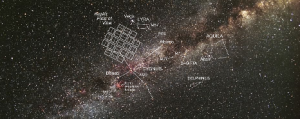The growing planetary family
At least 1,200 added to list of possible planets beyond the solar system

Planet hunters and space enthusiasts, rejoice! On February 2, astronomers announced the discovery of 1,235 possible new planets in the galaxy. These strange new worlds — near and far, large and small ― are called exoplanets, or extrasolar planets. They orbit stars other than the sun, racing through space far away from the solar system. Before the announcement, scientists knew about more than 500 exoplanets, so the new discovery brings the planetary count to more than 1,700.
“I’m just exhilarated we’ve found all these things already, and I’m awed that there are so many,” Bill Borucki told Science News. Borucki works at NASA’s Ames Research Center in Mountain View, Calif., and is chief scientist on the Kepler spacecraft.
The Kepler spacecraft is actually a telescope. The ultimate planet hunter, this powerful telescope made the discovery possible. As the spacecraft follows Earth around the sun, its telescope is always turned toward the same sliver of sky. Kepler beams back information about the hundreds of thousands of stars in its view. Its mission is to find the telltale changes in starlight that show a planet is nearby. When a planet transits, or passes between the star and the telescope, the starlight dims a bit, and then returns to normal. (To see for yourself, stare at a light source — but not the sun! — and slowly pass your hand back and forth in front of it, blocking and then unblocking the light.)
Kepler’s findings come from graphs of how starlight changes over time. The slight dimming caused by a passing planet shows up on the graph as a u-shaped dimple in the line. For astronomers, these dips are like planets introducing themselves.
The 1,235 possible planets Kepler found may seem like a lot, but it’s just the beginning: Kepler continuously monitors about 156,000 different stars.
“This is definitely our best first look at the galactic planetary census,” Greg Laughlin told Science News. (A planetary census aims to figure out how many planets are in the galaxy.) Laughlin is a theorist at the University of California, Santa Cruz and not part of the Kepler team. A theorist is someone who uses available data ― like telescope observations of planets — to build computer models that help describe or explain natural processes — like how many other planets might be out there.
Kepler boosts the search for life in the universe ― and some of the newly found planets are good places to look. Scientists are particularly interested in planets that orbit their stars far enough away that the planet isn’t too hot, and close enough that it’s not too cold. An orbit is the path a planet follows around its star, and this kind of orbit — not too hot, not too cold ― is said to be in the habitable zone. Habitable means that the planet could be inhabited by life. (It’s also called the Goldilocks Zone. Remember the three bears and their porridge?)
Of the potential newly found planets, 54 are in the Goldilocks Zone. Of those 54, the smallest five are roughly the same size as Earth. This combination — being Earth-sized and in the right place ― is part of the recipe for life on Earth. Scientists who study Earth-sized planets in the Goldilocks Zone could be the first to know whether life is out there.
Borucki told Science News that the larger planets recently discovered also offer hope. They’re probably made of gas, more like Saturn and Jupiter than Mars or Earth. But like Saturn and Jupiter, these giants could have rocky moons the size of Earth, and those moons might support liquid water and even life.
Of the 1,235 possible planets, 68 are about the same size as Earth. (This number includes some outside the Goldilocks Zone.) The rest are bigger, with 662 Neptune-sized worlds and 165 closer to the size of Jupiter. About three out of every 10 of the newfound planets orbit their stars along with other planets. That is to say, these planets are part of planetary systems. The solar system is a planetary system. One of these systems, recently found by Kepler, is particularly tight-knit: Six planets orbit the star, called Kepler-11, and five of them are closer to the star than Mercury is to the sun. All six are bigger than Earth, but less dense — which means they’re probably more like Neptune or Uranus than like Earth or Venus.
Changes in starlight helps scientists find planets and also measure the planets’ sizes. Next, researchers will study how the worlds move to figure out how massive, or bulky, they are. Mass is different from size: Mass describes how much stuff makes up an object. A bowling ball and a gob of cotton candy might be the same size, but the bowling ball is much heavier, which means it has more mass.
Measuring mass is important. It confirms the first findings and shows that an observed dip in starlight comes from a planet, and not from another passing star or some other source. Borucki and the other Kepler scientists predict at least 90 percent of Kepler’s candidates are real planets.
With this flood of new exoplanets, a new chapter begins in the search for Earth-like planets and other life in the cosmos.
Power Words
(adapted from the New Oxford American Dictionary)
exoplanet A planet that orbits a star that is outside the solar system.
light curve A graph showing the changing intensity of light coming from a distant object, such as a star.
mass A measure of the amount of matter in an object. Mass is related to gravity: More massive objects tug other objects toward it with a stronger pull. Mass can be determined by calculating how the gravity of one object, such as a star or planet, changes the motion of other, nearby stars or planets.







